How to Choose Lightweight Safety Shoes for Long Shifts
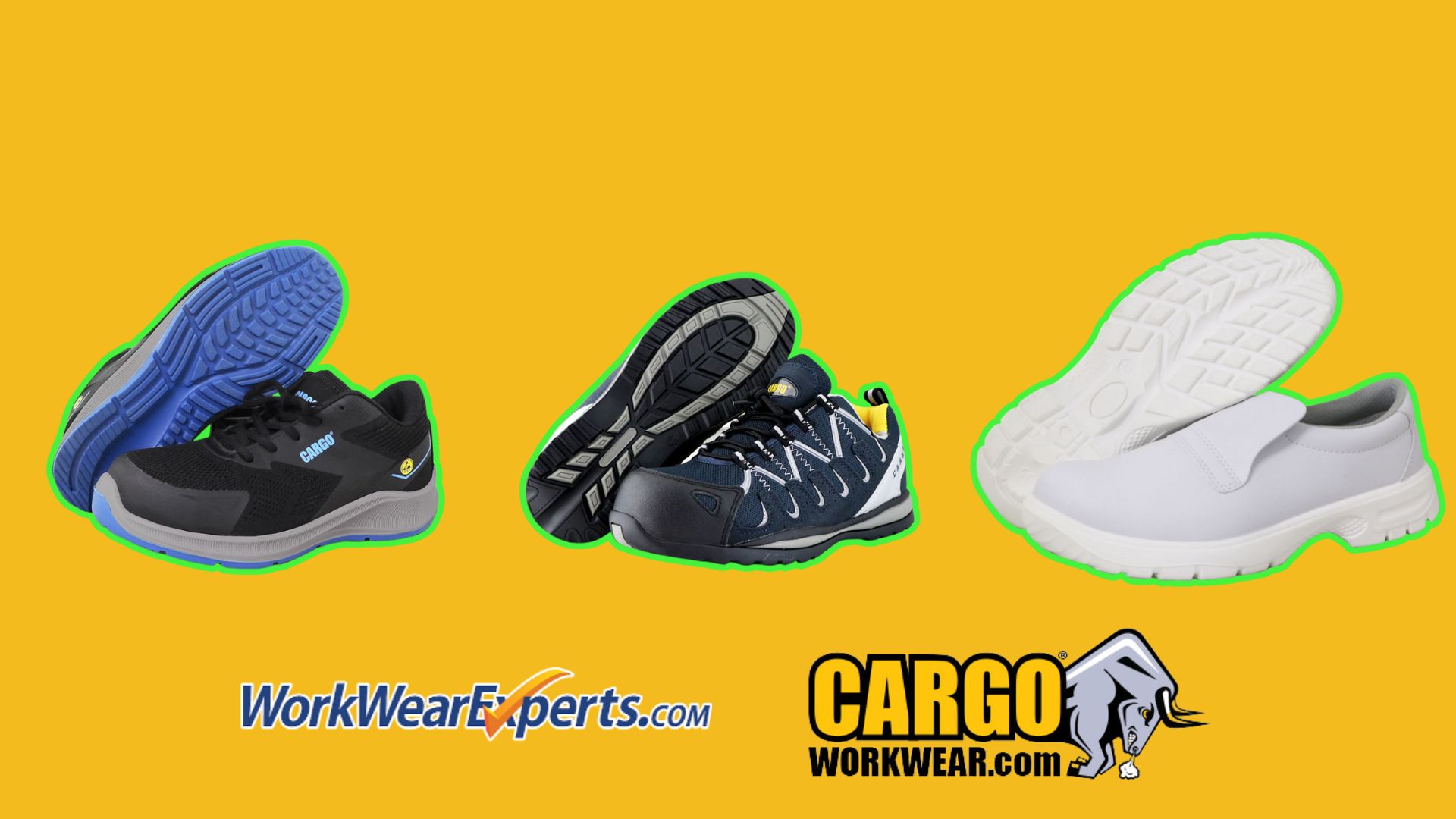
When working long shifts in physically demanding environments, the right footwear can make all the difference. Lightweight safety shoes or safety trainers offer essential protection without the bulk, helping to reduce fatigue while keeping your feet comfortable throughout the day.
Whether you're on a construction site, in a warehouse, or working outdoors, choosing the right pair of safety shoes is crucial for both your performance and well-being.
In this guide, we'll explore the key factors to consider when selecting lightweight safety shoes that meet the demands of your job, ensuring safety and comfort for those long hours on your feet.
TABLE OF CONTENTS
- Understanding Safety Standards
- Importance of Composite or Aluminium Toe Caps
- Importance of Comfort for Long Shifts
- Slip-Resistance for Safety
- Supporting Arch and Ankle Health
- Water and Chemical Resistance
- Shock Absorption and Energy Return
- Tailoring Shoes to Your Work Environment
Understanding Safety Standards
When choosing lightweight safety shoes for long shifts, it's essential to ensure they comply with recognised footwear safety standards. In Ireland, the most common classification is EN ISO 20345, which outlines the minimum safety requirements for footwear used in various professional environments. This standard ensures protection against workplace hazards such as impact, punctures, and slips.
Overview of EN ISO 20345 Standards
The EN ISO 20345 standard categorises safety footwear into different levels, based on the level of protection they offer:
- SB (Safety Basic): Basic protection, including a steel or composite toe cap, offering impact and compression resistance.
- S1: These shoes have toe protection, antistatic properties, energy absorption in the heel, and are resistant to oil and hydrocarbons. S1 shoes are ideal for dry indoor environments.
- S1P: Similar to S1 but with the added feature of a puncture-resistant midsole, making them suitable for environments where sharp objects could be present on the ground.
- S2: In addition to the features of S1, S2 shoes are water-resistant, protecting against occasional exposure to moisture.
- S3: Incorporates all the features of S2, along with puncture-resistant midsoles and cleated outsoles, making them ideal for outdoor environments where rough terrain and sharp objects are common.
Importance of Composite or Aluminium Toe Caps
Traditional safety footwear uses steel toe caps, which can be heavier. For lightweight safety shoes, composite or aluminium toe caps are preferred, as they provide the same level of protection while significantly reducing weight, helping reduce foot fatigue during long shifts.
- Composite Toe Caps: Made from non-metallic materials like plastic or fibreglass, composite toe caps are lighter than steel and provide excellent insulation from heat and cold, making them ideal for extreme conditions. Additionally, they don’t trigger metal detectors.
- Aluminium Toe Caps: Aluminium toe caps are strong, lightweight, and more compact than composite or steel alternatives. However, they may not offer the same insulation as composite materials in cold environments.
By selecting safety shoes that align with EN ISO 20345 standards and feature lightweight materials like composite or aluminium toe caps, you can ensure both safety and comfort throughout long shifts.
| Cargo Sneaker ESD Safety Trainer S1P SRC |
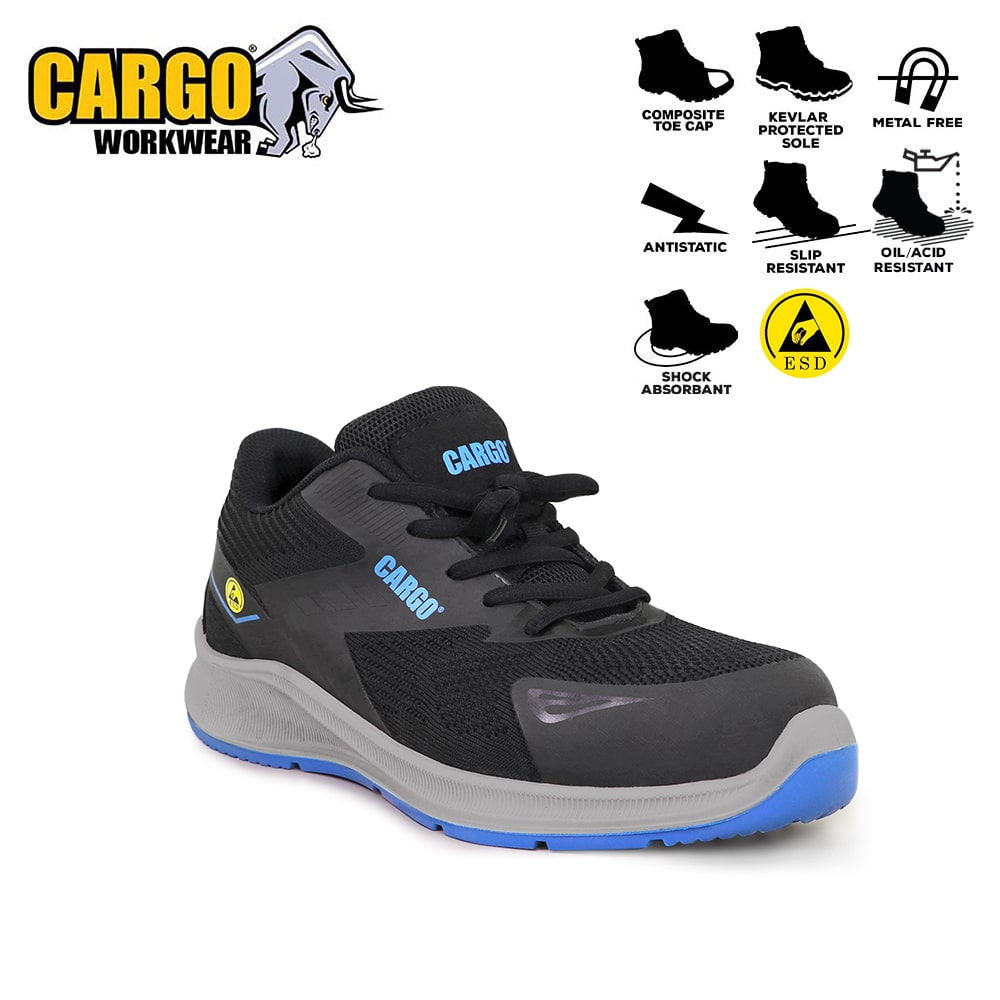 |
Importance of Composite or Aluminium Toe Caps
Traditional safety footwear uses steel toe caps, which can be heavier. For lightweight safety shoes, composite or aluminium toe caps are preferred, as they provide the same level of protection while significantly reducing weight, helping reduce foot fatigue during long shifts.
- Composite Toe Caps: Made from non-metallic materials like plastic or fibreglass, composite toe caps are lighter than steel and provide excellent insulation from heat and cold, making them ideal for extreme conditions. Additionally, they don’t trigger metal detectors.
- Aluminium Toe Caps: Aluminium toe caps are strong, lightweight, and more compact than composite or steel alternatives. However, they may not offer the same insulation as composite materials in cold environments.
By selecting safety shoes that align with EN ISO 20345 standards and feature lightweight materials like composite or aluminium toe caps, you can ensure both safety and comfort throughout long shifts.
Importance of Comfort for Long Shifts
When you're on your feet for hours at a time, comfort is just as important as safety. Poorly designed shoes can lead to foot pain, fatigue, and even long-term injuries. That’s why finding safety shoes that are lightweight, breathable, and well-cushioned is crucial for maintaining comfort throughout long shifts.
Breathable Materials
Long shifts can make your feet sweat, leading to discomfort and even foot conditions like blisters or fungal infections. Shoes made from breathable materials, such as mesh or perforated leather, allow air to circulate, keeping your feet dry and cool. These materials wick moisture away from the skin, helping to prevent overheating and excessive sweating, which is especially important in warm working environments.
Cushioned Insoles
Shock absorption is key when you’re standing or walking on hard surfaces for extended periods. Cushioned insoles are designed to provide that extra layer of comfort, helping to absorb the impact from each step. Look for shoes with memory foam or gel inserts, which conform to the shape of your feet, providing customised support. Cushioned insoles can also reduce the strain on your knees, ankles, and lower back, helping to keep you comfortable during long shifts.
Lightweight Design
Safety shoes are traditionally bulky and heavy due to their protective features, but modern advancements allow for lightweight designs without sacrificing safety. Lightweight shoes reduce the overall strain on your feet, legs, and back, helping to minimise fatigue. Materials like composite toe caps and EVA (ethylene vinyl acetate) soles help to reduce weight while maintaining durability and protection. The lighter the shoes, the less energy you expend lifting your feet, which can make a noticeable difference during a long workday.
Choosing shoes that combine breathable materials, cushioned insoles, and a lightweight design ensures your feet stay comfortable, cool, and well-supported, even during the longest shifts.
| Cargo Kelly Slip On Safety Shoe S2 SRC |
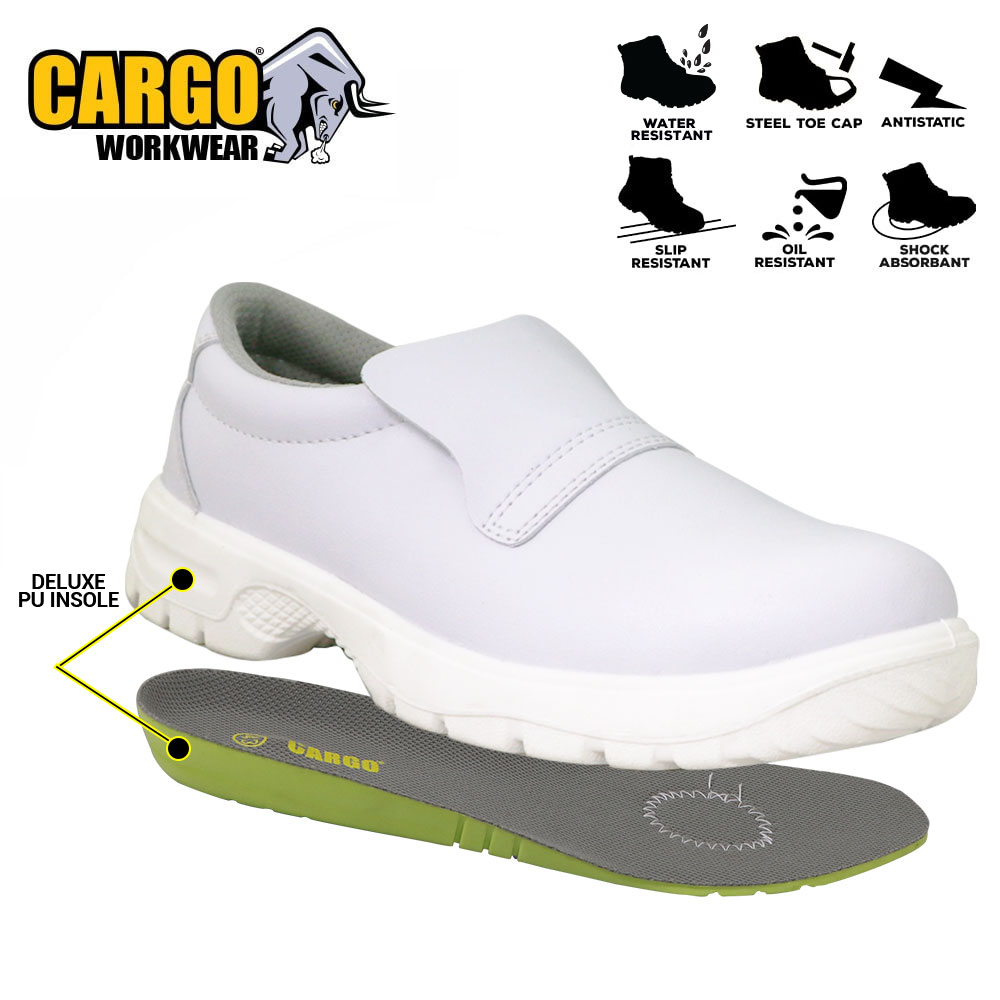 |
Slip-Resistance for Safety
One of the most important features of any safety shoe is its ability to prevent slips and falls, especially when working in environments where the floor may be wet, oily, or uneven. Slip-resistant shoes provide essential protection, helping to minimise the risk of accidents and ensuring you can move confidently throughout your shift.
SRC-Rated Soles for Slip Resistance
When selecting safety shoes, look for those with SRC-rated soles. SRC is the highest rating for slip resistance under the EN ISO 20345 standard. Shoes with this rating have been tested on both ceramic tiles with soapy water (SRA) and steel floors with glycerol (SRB), ensuring maximum grip in a variety of conditions. SRC-rated soles give you the peace of mind that your shoes will provide reliable traction on slippery surfaces, reducing the likelihood of accidents.
Handling Wet, Oily, or Uneven Surfaces
In many industries, floors are often exposed to liquids like water or oil, which can make them dangerously slippery. Slip-resistant shoes are designed with specific tread patterns and rubber compounds that improve grip, even on slick surfaces. Shoes with deep tread patterns and multi-directional grip can help channel away water or oil, maintaining traction and stability.
For workers who regularly encounter uneven surfaces, like those in construction or outdoor settings, slip-resistant shoes also provide better footing by offering more stability and control on rough terrain. The additional grip helps you keep your balance, which is particularly important when moving quickly or carrying heavy loads.
By investing in safety shoes with SRC-rated soles and strong slip-resistant properties, you can significantly reduce the risk of slips, trips, and falls, ensuring your safety in challenging work environments.
Supporting Arch and Ankle Health
When you're working long shifts on your feet, proper support for both your arches and ankles is critical to maintaining comfort and preventing injury. Without adequate support, prolonged standing or walking can lead to issues like plantar fasciitis, fatigue, and even long-term damage to your feet and joints.
Arch Support for Weight Distribution
Proper arch support is essential for distributing your body weight evenly across your feet. Shoes with poor or no arch support can cause your feet to bear too much pressure in certain areas, leading to discomfort and pain. Over time, this can result in chronic conditions such as plantar fasciitis or fallen arches.
Look for safety shoes designed with ergonomic insoles that provide targeted arch support, especially if you have high or flat arches. This helps in reducing strain on your feet, particularly during long shifts on hard surfaces. Arch support also contributes to better posture and alignment, which can relieve pressure on your knees, hips, and lower back.
Ankle Support for Stability
For workers who navigate uneven terrain, climb ladders, or carry heavy loads, ankle support is just as important as arch support. Shoes with higher cut designs that wrap around the ankles provide additional stability, reducing the risk of rolling or twisting your ankle, especially when moving on uneven surfaces or during quick, sharp movements.
Good ankle support not only prevents acute injuries like sprains but also helps to avoid long-term wear and tear on your joints. Whether you're working in construction, warehousing, or outdoors, shoes with reinforced ankle support can provide much-needed stability and balance, allowing you to perform your tasks confidently and safely.
By prioritising both arch and ankle support in your safety shoes, you can reduce the risk of discomfort, injury, and long-term foot problems, ensuring better overall health during long shifts.
Water and Chemical Resistance
In certain work environments, exposure to water and chemicals is inevitable, making it crucial to choose safety shoes that offer protection against these elements. Water-resistant and chemical-resistant shoes help keep your feet dry, comfortable, and safe from potentially harmful substances, ensuring you can work effectively throughout long shifts without compromising your safety.
When to Choose Water-Resistant Shoes
If you work outdoors or in environments where water is frequently present, such as construction sites or warehouses with wet floors, water-resistant shoes are essential. Safety shoes with a water-resistant rating, typically S2 or S3 under the EN ISO 20345 standards, prevent moisture from seeping into the shoe, keeping your feet dry throughout the day.
Water-resistant shoes are often made from materials like treated leather or synthetic fabrics that repel water while still allowing for some breathability. This helps prevent discomfort caused by dampness, blisters, or fungal infections that can result from prolonged exposure to wet conditions.
For industries where occasional water exposure is expected, such as logistics or transportation, choosing water-resistant footwear can ensure that you remain comfortable and focused on your tasks, without worrying about wet feet.
Protecting Against Chemicals
In certain industries, such as manufacturing, chemical processing, or laboratories, your shoes may come into contact with hazardous substances. In these cases, chemical-resistant safety shoes are a must. Shoes designed with chemical resistance are made from materials that withstand degradation from acids, oils, solvents, and other chemicals commonly found in these environments.
Safety shoes with chemical-resistant properties help protect your feet from burns, skin irritation, or other injuries caused by direct contact with hazardous substances. They also ensure that the integrity of the shoe material is maintained, preventing premature wear and tear. For workers exposed to harsh chemicals on a regular basis, investing in footwear that provides this added layer of protection is crucial to both safety and longevity.
By choosing water-resistant or chemical-resistant safety shoes, you can ensure that your feet remain protected from environmental hazards, allowing you to focus on the job at hand, no matter the conditions.
| Cargo Rio Safety Trainer S3 SRA |
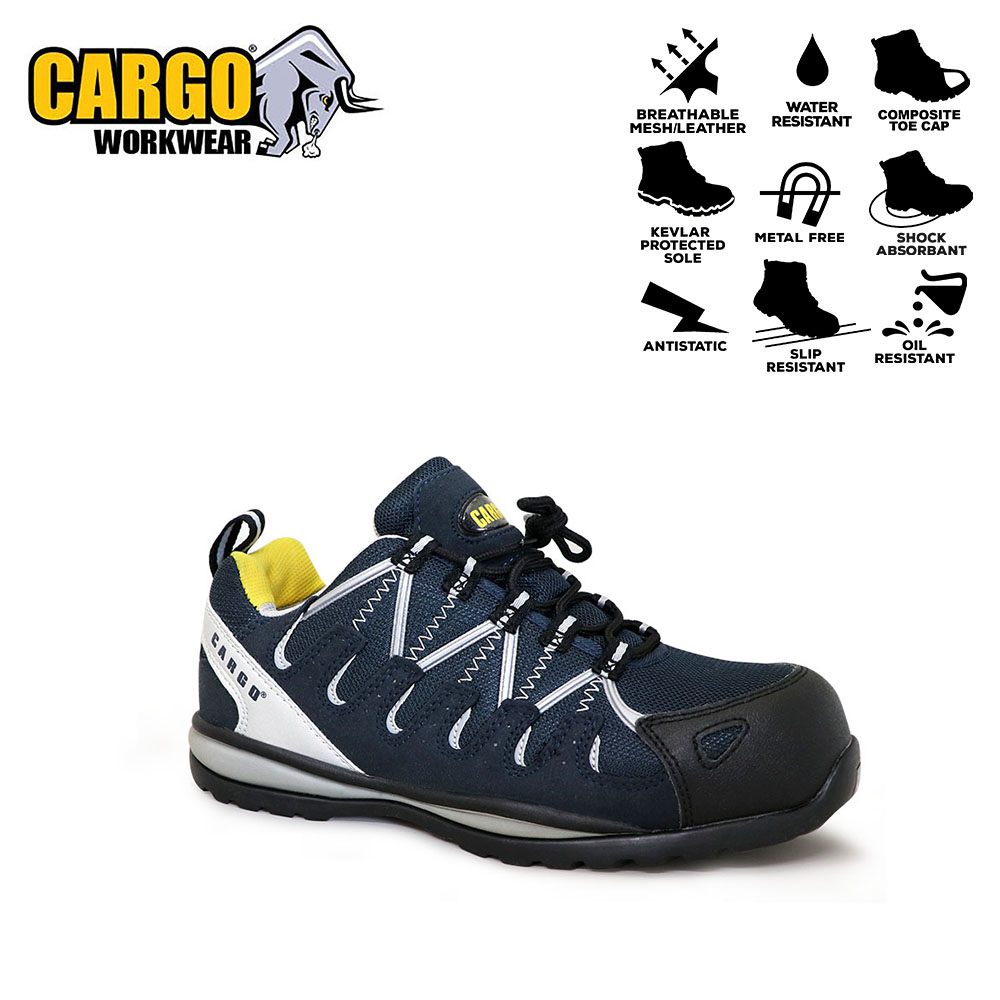 |
Shock Absorption and Energy Return
When working long shifts, especially on hard surfaces, the strain on your feet, legs, and back can lead to fatigue and discomfort. Choosing safety shoes with effective shock absorption and energy-return features can make a significant difference in reducing physical stress, helping you stay comfortable and focused throughout the day.
Reducing Fatigue with Shock-Absorbing Shoes
Shock absorption is crucial for mitigating the impact that occurs with every step, especially during long periods of standing or walking. Safety shoes designed with shock-absorbing midsoles, often made from materials like EVA (ethylene vinyl acetate) or PU (polyurethane), help cushion your feet from hard surfaces. This reduces the impact on your joints and muscles, minimising the risk of fatigue and injury.
For workers in industries such as construction, warehousing, or manufacturing, where standing and walking on concrete floors are common, shoes with built-in shock absorption can help reduce pressure on the feet and lower limbs, allowing you to stay more comfortable and energised for longer periods.
Energy-Return Technology
Energy-return technology is another advanced feature found in modern safety shoes. This technology works by returning some of the energy generated by your steps back into your stride, providing a slight "bounce" or push that helps reduce the effort required for walking.
By conserving energy with each step, shoes with energy-return soles help to minimise muscle fatigue, allowing you to stay active and alert throughout the day. This is particularly beneficial for workers who are on their feet for extended hours or need to walk long distances as part of their job. Energy-return technology is often found in lightweight safety shoes, providing a perfect balance between protection, comfort, and performance.
By selecting shoes with shock-absorbing properties and energy-return technology, you can significantly reduce the physical toll of long shifts, ensuring your feet remain supported and less fatigued, no matter how demanding the workday becomes.
Tailoring Shoes to Your Work Environment
Different work environments present unique challenges, so it’s important to choose safety shoes that are specifically designed for the hazards and demands of your particular job. Whether you're working indoors in a controlled environment or outdoors in unpredictable conditions, selecting the right shoes can enhance your safety, comfort, and performance.
Warehouse and Factory Workers
For those working in warehouses or factories, where standing for long periods and moving heavy objects is common, lightweight safety shoes with slip-resistant soles and shock absorption are key. Warehouses often have smooth, sometimes slick floors, making SRC-rated soles crucial to prevent slips. Additionally, shoes with good arch support and cushioning help to reduce fatigue when walking long distances on hard surfaces.
Shoes with anti-static properties may also be necessary, especially in environments where electrical discharges pose a risk. Prioritising lightweight designs will help prevent foot fatigue, allowing you to stay focused and productive during extended shifts.
Construction Workers
For construction workers, safety shoes need to offer maximum protection while still being comfortable enough for long hours. Construction sites often have uneven terrain and sharp objects on the ground, so S3-rated shoes are ideal as they come with puncture-resistant midsoles and cleated outsoles for extra grip.
Toe protection is a must, but instead of traditional steel toes, which can be heavy, opt for composite or aluminium toe caps to reduce the overall weight. High-cut designs with ankle support also help prevent injuries when walking on rough or sloped surfaces. For outdoor construction workers, water resistance is another essential feature, keeping your feet dry and comfortable in unpredictable weather conditions.
Hospitality Workers
In the hospitality industry, where long shifts are often spent on your feet in kitchens, restaurants, or hotels, comfort and slip resistance are critical. Hospitality workers need lightweight shoes with S1 or S1P ratings, which provide toe protection and slip-resistant soles that handle slick kitchen floors or dining areas with ease.
Breathability is also important to keep your feet cool, especially when working in hot environments like kitchens. Look for shoes with cushioned insoles and shock-absorbing properties to help reduce foot and leg fatigue during long hours of standing and walking.
Outdoor Workers
For those working outdoors, whether in landscaping, utilities, or agriculture, your shoes need to withstand the elements while keeping your feet comfortable and protected. Water-resistant shoes are a must to protect your feet from rain, mud, and other moisture. S3-rated shoes with puncture-resistant soles and deep treads provide protection against sharp objects and offer better grip on uneven, slippery, or muddy ground.
Additionally, insulation may be necessary if you're working in colder conditions, while breathable materials are key for keeping your feet cool in warmer weather. Choosing shoes that offer a balance of protection, support, and durability will ensure they perform well in various outdoor environments.
| Ohio Safety Trainer SB FO SRA |
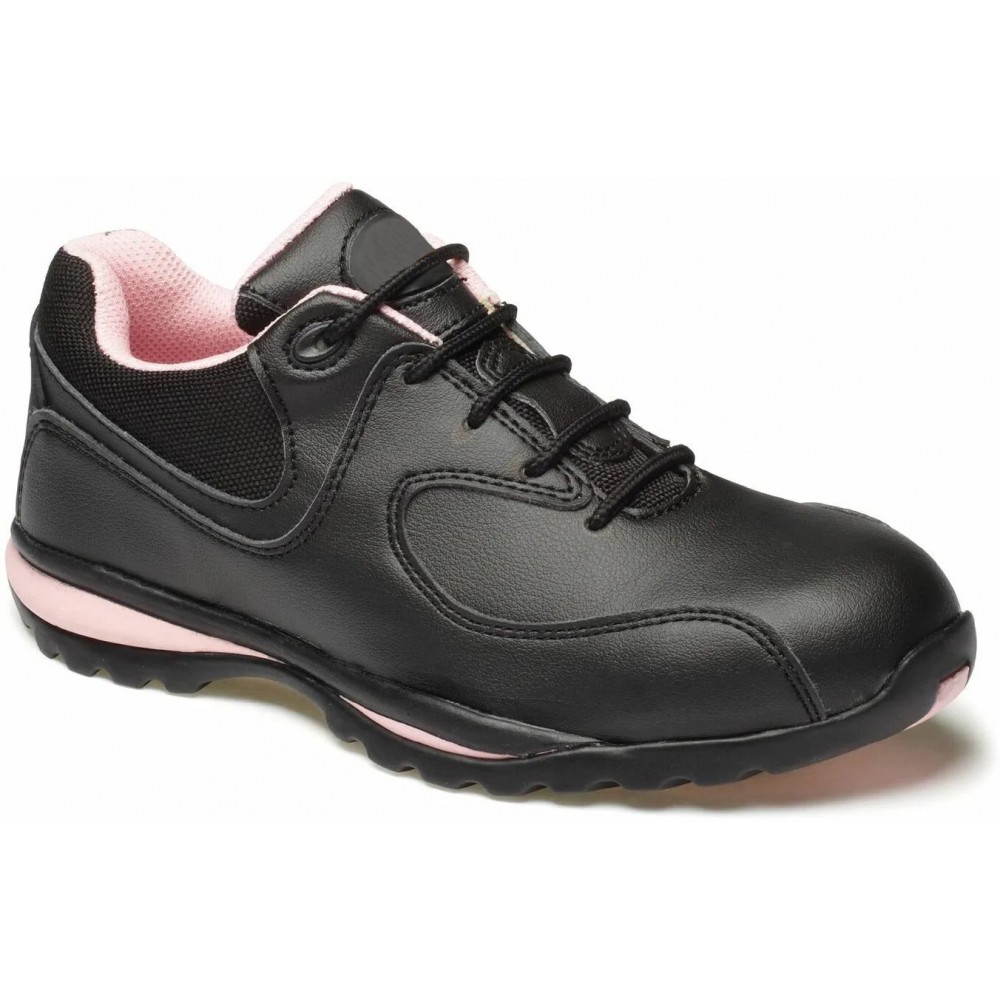 |
Conclusion
Choosing the right lightweight safety shoes for long shifts is essential for both your comfort and safety. By understanding the safety standards, prioritising comfort features like breathable materials and cushioned insoles, and selecting shoes tailored to your specific work environment, you can ensure your feet remain protected and fatigue-free throughout the day.
Investing in durable, high-quality shoes not only enhances your performance but also saves you money in the long run by reducing the need for frequent replacements.
At WorkwearExperts, we offer a wide range of lightweight safety shoes and safety trainers designed to meet the needs of various industries. Whether you’re working in construction, warehousing, or hospitality, we have the perfect pair to keep you safe and comfortable during those long shifts. Visit our store today to explore our selection and find the right safety footwear for your job.
Your email address cannot be published. Required fields are marked*
